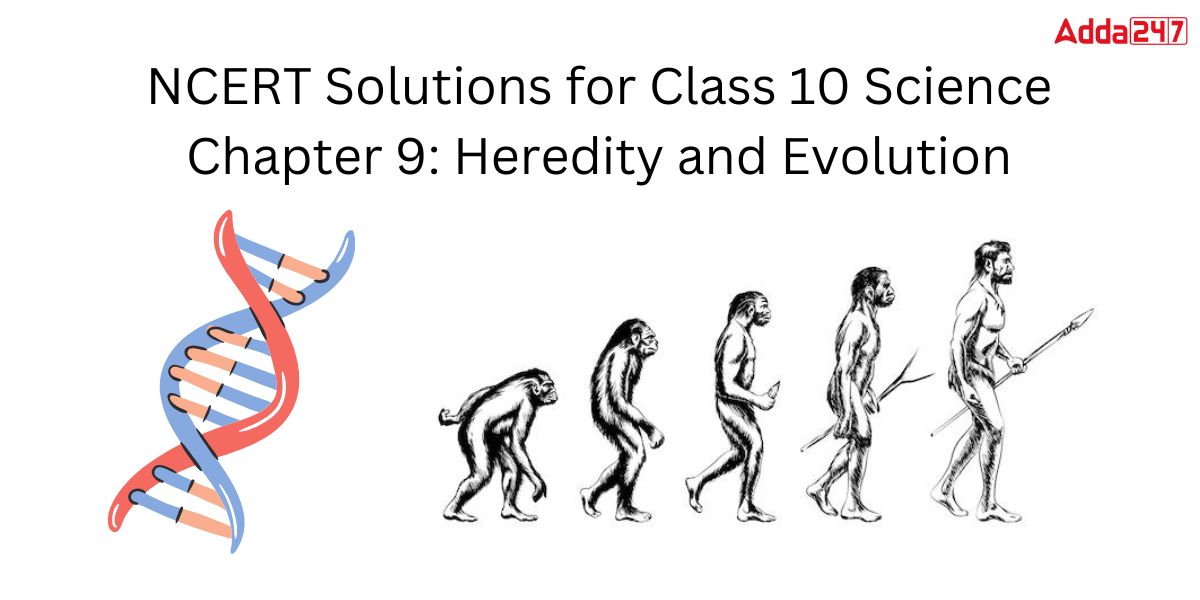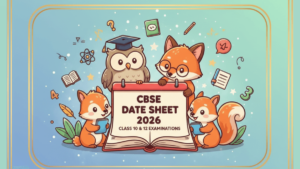Heredity and Evolution- NCERT Solutions for Class 10 Science Chapter 9 Notes
NCERT Solutions Class 10 Science Chapter 9 Heredity and Evolution is given in the article. NCERT Solutions Class 10 is the best resource for obtaining a good score in the class 10 board Examination. Your preparation for the CBSE examinations will be aided by the NCERT Solutions for Class 10 Science Chapter 9 Heredity and Evolution. Here are Adda247 Expert faculty team prepared NCERT Solutions Class 10 Science Chapter 9 Heredity and Evolution along with in-text questions and exercises of that chapter for a better grasp of the topics. These solutions will help you understand the concepts covered in the chapter completely. So that students can pass their board exams with good scores. Keep learning with Adda247.
Read: NCERT Solutions Class 10 Science Chapter 15 Our Environment
NCERT Solutions For Class 10 Science Chapter 9 Heredity and Evolution Question & Answer Pdf
NCERT Solutions for Class 10 Science Chapter 9 Heredity and Evolution can help you learn about natural resources, their availability, and their best management. Click here to download NCERT Solutions Class 10 Science Chapter 9 Heredity and Evolution.
NCERT Solutions for Class 10 Science Chapter 9: Heredity and Evolution: At a glance
Let’s take a quick look at the topics and subtopics covered in Chapter 9 Heredity and Evolution before solving the Intext questions and exercises.
- Heredity And Evolution
- Accumulation Of Variation During Reproduction
- Heredity
- Inherited Traits
- Rules for the Inheritance of Traits – Mendel’s Contributions
- How do these traits get Expressed
- Sex Determination
- Evolution
- An Illustration
- Acquired and Inherited Traits
- Speciation
- Evolution And Classification
- Tracing Evolutionary Relationships
- Fossils
- Evolution by Stages
- Evolution Should Not Be Equated With ‘Progress’
- Human Evolution
Class 10 Science Chapter 9: Heredity and Evolution: Video Explanation
NCERT Solutions for Class 10 Science Chapter 9: Heredity and Evolution
In-text Questions Page:143
1. If a trait A exists in 10% of a population of an asexually reproducing species and trait B exists in 60% of the same population, which trait is likely to have arisen earlier?
Asexual reproduction necessitates the involvement of a single parent and does not involve the fusion of haploid gametes, so trait B is more likely to have arisen earlier due to its higher percentage in the population and the fact that it has been existed and replicated in a larger percentage of the population than trait A. In this, the offspring born is genetically similar to the parents, meaning that their DNA is almost a copy of the parent’s DNA.
2. How does the creation of variations in a species promote survival?
The variations keep the population of different species stable by preventing them from going extinct in harsh conditions.
The species can better adapt to environmental changes due to genetic variation. Furthermore, it is a crucial force in evolution because it enables natural selection to alter the frequency of alleles. These differences will influence whether the species survives or becomes extinct.
In-text Questions Page:147
1. How do Mendel’s experiments show that traits may be dominant or recessive?
Mendel’s work on mono-hybrid crosses shows that characteristics can either be dominant or recessive. Mendel used pea plants that were tall and dwarf (or short), which had different properties. He obtained all tall plants in the first generation of cross-pollination (F1). However, because F1 tall plants are self-pollinated, the second generation of plants had a 3:1 ratio of tall to short trousers. Based on these studies, the traits that showed up in the first generation were referred to as dominant (for example, tall plants), while the traits that did not show up were referred to as recessive (dwarf i.e. plants). The idea that characteristics can either be dominant or recessive is therefore confirmed.
2. How do Mendel’s experiments show that traits are inherited independently?
Mendel’s dihybrid cross experiment demonstrates that characteristics are inherited independently. Mendel used seed color and seed shape as his two main characters in the experiment. use the two features of seed shape and seed color. On pea, he performed a hybrid cross by focusing on two characters at once. His dihybrid cross showed a diverse collection of genes. Round and yellow seeds (RRYY) were crossed with wrinkled and green seeds (rryy) by Mendel (parental generation). Since round seeds are preferred to wrinkled seeds and yellow seeds are preferred to green seeds, the first filial generation (F1) displayed only round and yellow seeds (law of dominance).
The F1 generation produced the F2 generation with a diversity of seeds. Yellow round, green round, yellow wrinkled, and green wrinkled seeds were present in F2 progeny in the ratios of 9:3:3:1.
Two new seed varieties, round green and wrinkled yellow, were present in the F2 generation (different from the parental types). Thus, it can be concluded that the two characters’ genes were assorted independently.
3. A man with blood group A marries a woman with blood group O and their daughter has blood group O. Is this information enough to tell you which of the traits – blood group A or O – is dominant? Why or why not?
4. How is the sex of the child determined in human beings?
In-text Questions Page:150
1. What are the different ways in which individuals with a particular trait may increase in a population?
2. Why are traits acquired during the lifetime of an individual not inherited?
3. Why are the small numbers of surviving tigers a cause of worry from the point of view of genetics?
In-text Questions Page:151
1. What factors could lead to the rise of a new species?
2. Will geographical isolation be a major factor in the speciation of a self-pollinating plant species? Why or why not?
3. Will geographical isolation be a major factor in the speciation of an organism that reproduces asexually? Why or why not?
In-text Questions Page:156
1. Give an example of characteristics being used to determine how close two species are in evolutionary terms.
2. Can the wing of a butterfly and the wing of a bat be considered homologous organs? Why or why not?
3. What are fossils? What do they tell us about the process of evolution?
In-text Questions Page:158
1. Why are human beings who look so different from each other in terms of size, colour and looks said to belong to the same species?
2. In evolutionary terms, can we say which among bacteria, spiders, fish, and chimpanzees have a ‘better’ body design? Why or why not?
NCERT Solutions for Class 10 Science Chapter 9: Exercises
1. A Mendelian experiment consisted of breeding tall pea plants bearing violet flowers with short pea plants bearing white flowers. The progeny all bore violet flowers, but almost half of them were short. This suggests that the genetic makeup of the tall parent can be depicted as
(a) TTWW
(b) TTww
(c) TtWW
(d) TtWw
2. An example of homologous organs is
(a) our arm and a dog’s fore-leg.
(b) our teeth and an elephant’s tusks.
(c) potato and runners of grass.
(d) all of the above.
3. In evolutionary terms, we have more in common with
(a) a Chinese school-boy.
(b) a chimpanzee.
(c) a spider.
(d) a bacterium.
4. A study found that children with light-coloured eyes are likely to have parents with light-coloured eyes. On this basis, can we say anything about whether the light eye colour trait is dominant or recessive? Why or why not?
5. How are the areas of study – evolution and classification – interlinked?
6. Explain the terms analogous and homologous organs with examples.
7. Outline a project which aims to find the dominant coat colour in dogs.
8. Explain the importance of fossils in deciding evolutionary relationships.
9. What evidence do we have for the origin of life from inanimate matter?
10. Explain how sexual reproduction gives rise to more viable variations than asexual reproduction. How does this affect the evolution of those organisms that reproduce
sexually?
11. How is the equal genetic contribution of male and female parents ensured in the
progeny?
12. Only variations that confer an advantage to an individual organism will survive in a population. Do you agree with this statement? Why or why not?












 CUET UG 2026 Online Registration Started...
CUET UG 2026 Online Registration Started...
 CUET 2026 Free Batches Launched by CUET ...
CUET 2026 Free Batches Launched by CUET ...
 CBSE Date Sheet 2026 for Class 10 & ...
CBSE Date Sheet 2026 for Class 10 & ...














